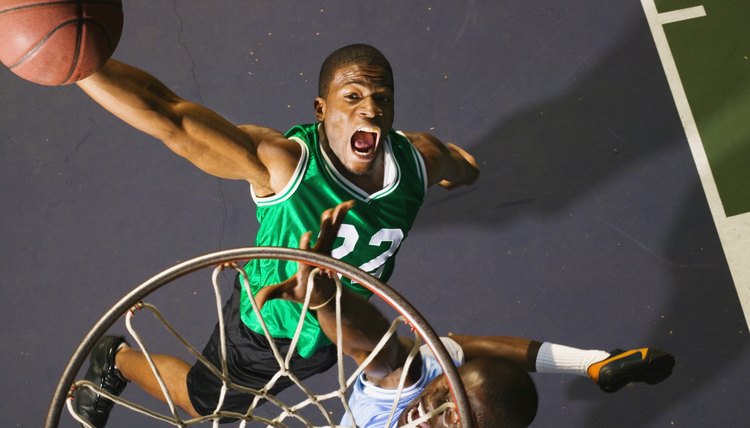Do Basketball Shoes Make You Jump Higher?

Some athletes can jump higher while wearing shoes designed to enhance jump height. Certain basketball shoe manufacturers claim that their shoes allow a player to jump 3 1/2 inches higher than the player can jump without the special shoes. Although shoe-design technology may focus attention on better jumping technique, jumping higher does not depend entirely upon the shoes. It was discovered that some players maintain a higher jump after wearing jump-enhancing -- spring-assisted -- basketball shoes, even when they wear their old footgear, according to Chris Ballard of "Sports Illustrated."
The Impact of Shoe Padding
Fast action on the hard surfaces of basketball courts causes many injuries to athletes. Basketball shoe manufacturers responded to this phenomenon by creating complicated cushioning systems in basketball shoes to reduce impact stress. However, while the shoes reduce impact injuries, the added padding absorbs some energy used to drive a jump, which reduces jump height.
Jumping Mechanics
Vertical jumping depends mostly on muscle strength, using the muscles of calves and upper legs to drive the body upward. Muscle elasticity also contributes to jumping height by storing and releasing energy. Maximum jumping height depends upon using the structure of the body correctly. Placing weight on the balls of the feet rather than the heels allows elastic energy storage in the Achilles tendon. The typical energy increase makes a difference of about 3 1/2 inches in jumping height, according to Ken Young of the University of Washington. This increase closely matches the results reported by Athletic Propulsion Labs during tests of their spring-loaded shoe.
Jump-Training Shoes
Special strength-training shoes contribute to jumping ability by forcing the wearers to put weight on the forward part of the foot. Thick soles on the front part of the training shoes lift the heel off the floor. The shoes put emphasis on calf strength and prevent the player from driving the heel downwards instead of using the natural resilience of the foot. Athletes see improved jumping ability when returning to regular footgear.
Compression-Spring Shoes
Banned by the National Basketball Association, performance-enhancing spring-loaded shoes increase jumping height through better technology, according to Athletic Performance Labs. A compression spring in the ball area of the shoe stores energy when the athlete plants the foot for the jump, and during the propulsion part of the movement transfers energy back to both ball and heel through a patented embedded bar in the shoe's sole. Players do report improvements in jumping height, but those improvements linger even when athletes shift to other shoes. The new shoes encourage better form, but so does an hour of training with a good coach, says Chris Ballard of "Sports Illustrated."
References
Writer Bio
James Young began writing in 1969 as a military journalist combat correspondent in Vietnam. Young's articles have been published in "Tai Chi Magazine," "Seattle Post-Intelligencer," Sonar 4 ezine, "Stars & Stripes" and "Fine Woodworking." He has worked as a foundryman, woodturner, electronics technician, herb farmer and woodcarver. Young graduated from North Seattle Community College with an associate degree in applied science and electronic technology.
